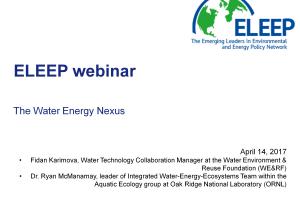This webinar explores the nexus between water and energy.
The first presentation is: Breaking Barriers to Fuel Innovation, by Fidan Karimova
Utilities in the water industry face a variety of challenges in meeting future demands and many of them are dealing with technology that is becoming outdated. A shift in mindset and acceptance of innovation can help them become better stewards of the water environment while reducing costs. This is where the Water Environment and Reuse Foundation’s (WE&RF’s) technology program comes into to the picture. The program, called Leaders Innovation Forum for Technology (LIFT), helps determine the specific utility needs that need to be addressed and find the technologies that could meet those needs through a match-making process. One such example that will be highlighted today is the Genifuel project. The Genifuel hydrothermal processing (HTP) technology can convert organic wastewater material into biocrude oil or natural gas.
The second presentation is: Building city land-energy-water networks to connect disparate policy sectors and conserve biodiversity, by Ryan McManamay
Sustainable city growth requires addressing the predominant pathways in which urbanization impacts the water cycle and biodiversity. This requires balancing competition among cities and sectors, while supporting communication among disparate policies. I’ll discuss a framework to translate city-scale impacts into indicators describing hydrologic and biodiversity impacts in riv-ers. Through land transformation, electricity production, and water supply development, individ-ual cities impact distal ecosystems, altering hydrology for thousands of stream kilometers and inducing local extinctions for hundreds of aquatic species. Furthermore, these impacts are not a function of population size, per se. Our results suggest that cities have a choice to minimize future impacts to aquatic ecosystems by fostering low-impact land transformation, large-scale stormwater control, and water-neutral electricity production to meet their energy demands. Additionally our team has built a decision-support tool for cities to optimize their future growth, including energy and water infrastructure under a wide range of scenarios.
About our speakers:
Fidan Karimova is the Water Technology Collaboration Manager at the Water Environment & Reuse Foundation (WE&RF), in charge of bridging the gap between the WE&RF utility sub-scriber needs and available technologies in the market. She has an extensive knowledge of the innovation industry, having previously worked on helping entrepreneurs from around the world transition from idea to implementation phase. Fidan created a mobile app, called the Water Tracker, which records the amount of water used in people’s daily lives. Fidan graduated from the University of Maryland with a Bachelor’s degree in International Business and a Master’s degree in Environmental Management. Most recently she successfully completed a three course certificate series in Water Management from Delft University of Technology.
Dr. Ryan McManamay is an alumni of ELEEP and the leader of Integrated Water-Energy-Ecosystems Team within the Aquatic Ecology group at Oak Ridge National Laboratory (ORNL) in Tennessee. He is also the lead of the Energy-Water-Nexus theme for the Urban Dynamics In-stitute (ORNL) and a joint faculty member of the Bredesen Center at the University of Tennes-see-Knoxville. His research includes applications of the energy-water-nexus to urban dynamics, as well as aspects of hydrology, biogeography, community and ecosystem ecology, and conservation/restoration planning.






